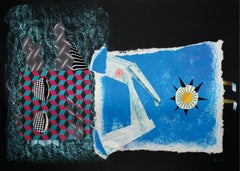Berlin - Figurative Drawings and Watercolors
2010s Contemporary Berlin - Figurative Drawings and Watercolors
Paper, Wax Crayon, Acrylic, Tempera
2010s Expressionist Berlin - Figurative Drawings and Watercolors
Canvas, Color Pencil
2010s Contemporary Berlin - Figurative Drawings and Watercolors
Paper, Ink
2010s Expressionist Berlin - Figurative Drawings and Watercolors
Canvas, Color Pencil
2010s Contemporary Berlin - Figurative Drawings and Watercolors
Paper, Spray Paint, Tempera
2010s Contemporary Berlin - Figurative Drawings and Watercolors
Paper
2010s Expressionist Berlin - Figurative Drawings and Watercolors
Canvas, Color Pencil
2010s Contemporary Berlin - Figurative Drawings and Watercolors
Paper
2010s Expressionist Berlin - Figurative Drawings and Watercolors
Canvas, Color Pencil
2010s Contemporary Berlin - Figurative Drawings and Watercolors
Ink, Paper
2010s Expressionist Berlin - Figurative Drawings and Watercolors
Canvas, Color Pencil
2010s Abstract Expressionist Berlin - Figurative Drawings and Watercolors
Canvas, Color Pencil
2010s Contemporary Berlin - Figurative Drawings and Watercolors
Paper
2010s Contemporary Berlin - Figurative Drawings and Watercolors
Paper
2010s Contemporary Berlin - Figurative Drawings and Watercolors
Paper, Tempera
2010s Contemporary Berlin - Figurative Drawings and Watercolors
Paper, Ink, Tempera
2010s Contemporary Berlin - Figurative Drawings and Watercolors
Paper, Tempera
2010s Contemporary Berlin - Figurative Drawings and Watercolors
Paper, Wax Crayon
1950s Realist Berlin - Figurative Drawings and Watercolors
Watercolor
2010s Surrealist Berlin - Figurative Drawings and Watercolors
Paper, Color Pencil
2010s Surrealist Berlin - Figurative Drawings and Watercolors
Paper
2010s Abstract Expressionist Berlin - Figurative Drawings and Watercolors
Paper, Oil
2010s Contemporary Berlin - Figurative Drawings and Watercolors
Paper, Spray Paint
Early 20th Century Realist Berlin - Figurative Drawings and Watercolors
Paper
2010s Expressionist Berlin - Figurative Drawings and Watercolors
Canvas, Color Pencil
Early 1900s Realist Berlin - Figurative Drawings and Watercolors
Paper
2010s Expressionist Berlin - Figurative Drawings and Watercolors
Canvas, Color Pencil
1880s Realist Berlin - Figurative Drawings and Watercolors
Chalk
2010s Contemporary Berlin - Figurative Drawings and Watercolors
Paper
1850s Naturalistic Berlin - Figurative Drawings and Watercolors
Pencil
1990s Realist Berlin - Figurative Drawings and Watercolors
Charcoal
Early 20th Century Realist Berlin - Figurative Drawings and Watercolors
Paper
1880s Realist Berlin - Figurative Drawings and Watercolors
Watercolor
Early 1900s Naturalistic Berlin - Figurative Drawings and Watercolors
Watercolor
1890s Realist Berlin - Figurative Drawings and Watercolors
Pencil
1990s Surrealist Berlin - Figurative Drawings and Watercolors
Watercolor, Pencil
2010s Neo-Expressionist Berlin - Figurative Drawings and Watercolors
Paper, Color Pencil
2010s Neo-Expressionist Berlin - Figurative Drawings and Watercolors
Paper, Color Pencil
Early 20th Century Realist Berlin - Figurative Drawings and Watercolors
Watercolor
1890s Academic Berlin - Figurative Drawings and Watercolors
Cardboard, Carbon Pencil
1990s Surrealist Berlin - Figurative Drawings and Watercolors
Watercolor, Etching
1880s Realist Berlin - Figurative Drawings and Watercolors
Chalk
1920s Realist Berlin - Figurative Drawings and Watercolors
Watercolor
1910s Realist Berlin - Figurative Drawings and Watercolors
Watercolor
1890s Realist Berlin - Figurative Drawings and Watercolors
Pencil
2010s Neo-Expressionist Berlin - Figurative Drawings and Watercolors
Paper, Color Pencil
2010s Expressionist Berlin - Figurative Drawings and Watercolors
Canvas, Color Pencil
2010s Expressionist Berlin - Figurative Drawings and Watercolors
Canvas, Color Pencil
2010s Neo-Expressionist Berlin - Figurative Drawings and Watercolors
Paper, Color Pencil
2010s Neo-Expressionist Berlin - Figurative Drawings and Watercolors
Paper, Color Pencil
2010s Neo-Expressionist Berlin - Figurative Drawings and Watercolors
Paper, Color Pencil
2010s Expressionist Berlin - Figurative Drawings and Watercolors
Canvas, Color Pencil
2010s Abstract Expressionist Berlin - Figurative Drawings and Watercolors
Paper, Oil
2010s Neo-Expressionist Berlin - Figurative Drawings and Watercolors
Color Pencil, Paper
2010s Neo-Expressionist Berlin - Figurative Drawings and Watercolors
Paper, Color Pencil
2010s Neo-Expressionist Berlin - Figurative Drawings and Watercolors
Color Pencil, Paper
2010s Neo-Expressionist Berlin - Figurative Drawings and Watercolors
Paper, Color Pencil
2010s Neo-Expressionist Berlin - Figurative Drawings and Watercolors
Color Pencil, Paper


